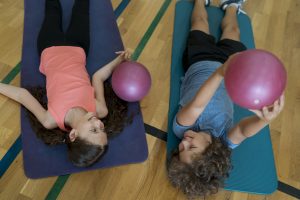Motor skills are the foundation of every child’s physical and cognitive growth. They are generally divided into two main categories: Gross Motor Skills and Fine Motor Skills. Understanding the difference between them helps parents and educators provide better activities for children’s healthy development.

What Are Gross Motor Skills?
Gross motor skills involve large muscle groups such as legs, arms, and core muscles. These skills are essential for overall body movement, posture, and coordination.
Examples include: running, jumping, climbing, swimming, pushing, and catching a large ball.
The main goals of gross motor activities are:
- Building balance and stability
- Developing agility and coordination
- Increasing body strength and endurance
Children usually develop gross motor skills before fine motor skills, as large muscle movements are easier to control in the early stages of growth.
What Are Fine Motor Skills?
Fine motor skills focus on small, precise movements, mostly using the muscles of the hands and fingers. These skills are crucial for daily tasks and academic performance.
Examples include: writing, drawing, buttoning clothes, cutting with scissors, or playing with clay.
The main goals of fine motor activities are:
- Improving hand–eye coordination
- Increasing accuracy and control
- Supporting independence in everyday activities
Impact of Media Use on Children’s Motor Skills
With the growing use of screens, many children spend less time in physical play. This directly affects their motor skill development.
1. Reduced Physical Activity (Gross Motor)
Excessive screen time reduces opportunities for running, jumping, or outdoor play, which may weaken coordination, balance, and agility.
2. Limited Fine Motor Development
Although some video games improve finger agility, they cannot replace real-life skills such as writing, cutting, or drawing. Children overexposed to touchscreens may struggle with handwriting and precise hand control.
3. Brain and Attention Effects
Too much media lowers attention span, making it harder for children to practice and master new motor skills.
4. Positive Media Opportunities
When guided, media can be useful. Educational videos, interactive movement-based games (like Nintendo Switch or Xbox Kinect), and exercise tutorials can support motor learning—especially when combined with real physical play.
Impact of Media on Overall Child Development
Cognitive Development
Balanced media use can help children learn colors, numbers, and language. But overuse limits imagination and creative thinking.
Social Development
Excessive use of tablets and phones reduces face-to-face interaction, weakening communication and empathy. Interactive family media use, however, can encourage conversations and bonding.
Motor Development
Passive media (like TV watching) leads to sedentary behavior, while interactive media supports motor growth if paired with active play.
Emotional Development
Uncontrolled exposure can increase anxiety and irritability. Properly guided media use, on the other hand, can support emotional learning and relaxation.
Activating the Senses Through Play
Children learn best when all senses are engaged. Sensory activities stimulate the Sensory–Motor System, which links senses with movement.
- Sight (Visual): tracking a ball, picture puzzles
- Hearing (Auditory): music games, sound imitation
- Touch (Tactile): playing with sand, clay, fabrics
- Smell & Taste (Olfactory & Gustatory): identifying scents, tasting fruits
- Muscle & Joint Sense (Proprioception): jumping, pushing, stretching
- Balance (Vestibular): swinging, rolling, walking on a balance beam
These activities build coordination, focus, emotional regulation, and confidence.
What Is the Sensory–Motor System?
The Sensory–Motor System connects sensory inputs (sight, hearing, touch, smell, taste, proprioception, balance) with motor outputs (gross and fine motor skills).
It is essential for:
- Learning and cognitive growth (reading, writing, problem-solving)
- Emotional stability and self-regulation
- Social interaction and teamwork
- Building confidence through physical control
Activities to Stimulate the Sensory–Motor System
- Jumping on a trampoline or skipping rope (balance + coordination)
- Playing with LEGO, sand, or clay (tactile + fine motor)
- Ball games (visual + gross motor)
- Rhythm and music activities (auditory + movement)
- Kids’ yoga and freeze games (balance + focus)
FAQs
-
What is the difference between gross and fine motor skills?
Gross motor skills use large muscles for running, jumping, and balance. Fine motor skills use small muscles for writing, buttoning, and drawing.
-
How does media affect motor skills in children?
Excessive screen time reduces physical play, delaying both gross and fine motor development. Controlled media use, combined with active play, can be beneficial.
-
What activities help children develop motor skills?
Outdoor play, ball games, drawing, cutting, and sensory activities like playing with clay or sand are highly effective.
-
Why is the sensory–motor system important?
It forms the foundation for learning, emotional balance, social development, and physical confidence in children.
Refrences
- American Academy of Pediatrics (AAP). Media and Young Minds (Policy Statement, 2016).
- Strasburger, V. C., & Hogan, M. J. (2013). Children, Adolescents, and the Media. Pediatrics, 132(5), 958–961.
- Christakis, D. A. (2009). The Effects of Infant Media Usage: What Do We Know and What Should We Learn? Acta Paediatrica.
- Ayres, A. J. (2005). Sensory Integration and the Child. Los Angeles: Western Psychological Services.
- Bundy, A. C., Lane, S. J., & Murray, E. A. (2002). Sensory Integration: Theory and Practice.
- Case-Smith, J. (2014). Occupational Therapy for Children and Adolescents.
Gabbard, C. (2017). Lifelong Motor Development.
- Gallahue, D. L., Ozmun, J. C., & Goodway, J. D. (2012). Understanding Motor Development: Infants, Children, Adolescents, Adults.
- WHO Guidelines on Physical Activity, Sedentary Behaviour and Sleep for Children Under 5 Years of Age (2019).
